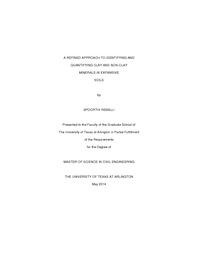
ATTENTION: The works hosted here are being migrated to a new repository that will consolidate resources, improve discoverability, and better show UTA's research impact on the global community. We will update authors as the migration progresses. Please see MavMatrix for more information.
Show simple item record
| dc.contributor.author | Reballi, Spoorthi | en_US |
| dc.date.accessioned | 2014-07-14T20:19:26Z | |
| dc.date.available | 2014-07-14T20:19:26Z | |
| dc.date.issued | 2014-07-14 | |
| dc.date.submitted | January 2014 | en_US |
| dc.identifier.other | DISS-12645 | en_US |
| dc.identifier.uri | http://hdl.handle.net/10106/24375 | |
| dc.description.abstract | Expansive soils exhibit substantial swelling and shrinkage due to moisture fluctuations. Predicting this volume change behavior of expansive soils has been a major challenge to the engineers in the past few years. One of the factors which play a vital role in understanding the behavior of the expansive soils is mineralogy. Chittoori (2008) had developed three models to quantify the clay minerals using Microsoft Excel Solver, Regression Equations and Artificial Neural networks. The major assumption is that the soil has only three mineral Montmorillonite, Kaolinite and Illite. But the amorphous contents like quartz and feldspar were not taken in to consideration. Hence the main objective of this research is to target the scope of finding the accurate method for quantification of the clay minerals present in the soil by giving the percentage of amorphous contents like feldspar and quartz using the regression model developed by Chittoori (2008). In order to accomplish this research, seventeen natural soils samples were taken with different mineralogical contents. Basic soil classification tests like hydrometer, wet sieve analysis were performed on these soils to identify the type of soil and for the separation of silt and clay fraction along with greater than 75 microns samples. Mineralogy studies on the test soils include Cation exchange capacity (CEC), Specific Surface Area (SSA) and Total Potassium (TP). The results from these tests were analyzed using the regression model developed by Chittoori (2008) and also by the modified method which identifies the mineral feldspar and quartz. Results from both the methods were compared and minerals kaolinite and Illite has shown considerable change in the predicted percentages. This research paves way for future research studies to increase the accuracy of the mineral quantification process by quantifying both the clay and non-clay minerals present in the soil and to understand the expansive behavior of soils. | en_US |
| dc.description.sponsorship | Puppala, Anand | en_US |
| dc.language.iso | en | en_US |
| dc.publisher | Civil & Environmental Engineering | en_US |
| dc.title | A Refined Approach To Identifying And Quantifying Clay And Non -clay Minerals In Expansive Soils | en_US |
| dc.type | M.S. | en_US |
| dc.contributor.committeeChair | Puppala, Anand | en_US |
| dc.degree.department | Civil & Environmental Engineering | en_US |
| dc.degree.discipline | Civil & Environmental Engineering | en_US |
| dc.degree.grantor | University of Texas at Arlington | en_US |
| dc.degree.level | masters | en_US |
| dc.degree.name | M.S. | en_US |
Files in this item
- Name:
- Reballi_uta_2502M_12645.pdf
- Size:
- 3.444Mb
- Format:
- PDF
This item appears in the following Collection(s)
Show simple item record


